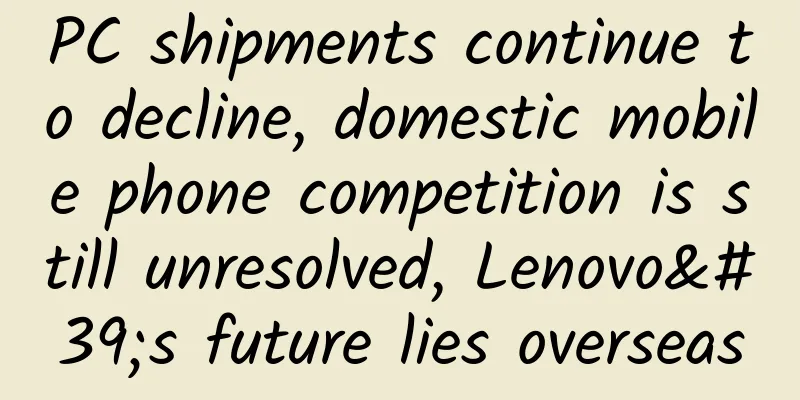PC shipments continue to decline, domestic mobile phone competition is still unresolved, Lenovo's future lies overseas

|
Lenovo Group released its financial report for the first quarter ended June 30, 2016 (the second quarter of 2016). Lenovo Group's revenue in the second quarter was US$10.1 billion, a year-on-year decrease of 6%. Since the fourth quarter of 2015, Lenovo has experienced negative revenue growth for three consecutive quarters. In the second quarter, Lenovo Group's net profit increased by 64% year-on-year to US$173 million. Currently, Lenovo Group divides its business into four major sectors: Personal Computer and Intelligent Devices Group (hereinafter referred to as "Lenovo PC"), Mobile Business Group, Data Center Business Group and Lenovo Venture Capital Group and others. Among them, Lenovo PC accounts for nearly 70% of total revenue, Lenovo Mobile accounts for nearly 20% of total revenue, and all other businesses account for about 10% of Lenovo's total revenue. The Data Center Business Group (DCG) was established in June this year on the basis of the original enterprise business group. Lenovo hopes to expand its advantages in the field of IT solutions. The group's revenue accounts for about 10% of Lenovo's overall revenue, but the growth is slow. In the second quarter of this year, Lenovo's data center business revenue increased by 1% year-on-year to US$1.086 billion. The business continued to perform strongly in China, with revenue increasing by 14% year-on-year. However, market competition outside of China remains fierce and has declined year-on-year. Lenovo Capital Group, with an investment of USD 500 million from Lenovo Group, will mainly invest in four fields, namely cloud computing + big data, artificial intelligence + robotics, Internet + and consumer upgrade. Due to its long investment cycle, the revenue it can contribute in the short term is limited. Both PC and mobile phone businesses have hit a low point The worst news for Lenovo is that its two most important businesses have both entered a downturn. Although Lenovo's PC market share has not declined significantly and it firmly holds the top spot in the world's PC market, Lenovo's PC has not been spared due to the continuous decline in the global PC market. From the second quarter of 2015 to the present, Lenovo's PC revenue has experienced negative growth year-on-year for six consecutive quarters. Lenovo's second largest business, Lenovo Mobile, has also reached a low point. Since the fourth quarter of 2015, Lenovo Mobile has experienced negative year-on-year growth for three consecutive quarters. In the fourth quarter of 2014, Lenovo Mobile Business Group's revenue was 3.4 billion US dollars, a year-on-year increase of 109%, which seems to be an eye-catching performance. However, it should be pointed out that the above growth is mainly due to the fact that Motorola's revenue was not included in Lenovo's financial report in the same period last year. Starting from the fourth quarter of 2014, Motorola's revenue was officially included in Lenovo Mobile Business Group. Motorola's sales in the quarter exceeded 10 million units, bringing a turnover of 1.9 billion US dollars to the Mobile Business Group. Interestingly, Lenovo Mobile's revenue in the second quarter of this year was $1.7 billion, which was almost the same as the $1.6 billion in the same period two years ago. Considering that Motorola was not included in Lenovo's financial report two years ago, but Motorola was included in Lenovo's revenue two years later, at least from the revenue dimension, Lenovo's acquisition of Motorola did not revitalize its mobile phone business. When Lenovo integrated Motorola, it said it would turn losses into profits within 4-6 quarters. However, according to the second quarter 2016 financial report, Lenovo Mobile Business Group's total pre-tax loss was US$206 million, with a pre-tax loss rate of 12.1%. However, although Lenovo's revenue continued to decline year-on-year, fortunately, costs were effectively controlled and net profit did not drop significantly. Instead, it achieved a certain degree of year-on-year growth. On August 13, 2015, Lenovo Group disclosed in its second quarter financial report that it would lay off employees and restructure globally, and implement a $1.3 billion cost-saving plan. This resulted in Lenovo Group incurring one-time expenses of $923 million in the third quarter of 2015, including $599 million in restructuring expenses and $324 million in expenses for clearing smartphone inventory. Lenovo Group suffered a loss of $714 million in the quarter, which was also the first loss for Lenovo Group in six years since the financial crisis. Although Lenovo paid a huge price, layoffs and restructuring saved its profitability to a certain extent. Since the fourth quarter of 2015, Lenovo Group has turned losses into profits, and its net profit has remained at a relatively stable level. Overseas markets may be Lenovo Mobile's lifeline For Lenovo, PC business accounts for about 70% of its overall revenue. However, the global PC industry has entered its most difficult period, with shipments declining for at least eight consecutive quarters. It is unlikely that Lenovo can turn things around and rely on the global PC industry to revive. Lenovo's mobile business accounts for about 20% of Lenovo Group's overall revenue. Last year, Lenovo Mobile shipped 66 million mobile phones worldwide. Compared with Chinese mobile phone manufacturers, it is second only to Huawei (108 million units shipped), TCL (80 million units, mainly sold overseas, half of which rely on feature phones) and Xiaomi (more than 70 million units). In the second quarter of this year, Lenovo Mobile's global mobile phone shipments fell again by 13% year-on-year to 11.2 million units. Lenovo said that the decline in mobile phone sales was mainly due to product transformation in the Americas region and macroeconomic challenges in Latin America. However, most of Lenovo Mobile's mobile phones are sold overseas. Last year, Lenovo Mobile shipped 51 million mobile phones overseas. In the Chinese mobile phone market, Lenovo only sold 15 million units last year, which is not as good as Huawei, Xiaomi, OPPO, Vivi and Meizu in the same period, and it is not even in the top five. After each Lenovo financial report is released, the outside world often compares it with Huawei. However, Lenovo started with "trade, industry and technology" (trade first), while Huawei started with "technology, industry and trade" (technology first). The two companies took different paths from the beginning and are not very comparable. However, the two companies did have a lot in common in the mobile phone market, that is, they were both highly dependent on operators. The emergence of Lei Jun and his Xiaomi caused extreme panic among other Chinese mobile phone manufacturers. Many manufacturers, including Huawei, followed Xiaomi's model and began to downplay operator channels. Huawei also cut off its low-end mobile phone business and focused on high-end Huawei phones, while the low-end thousand-yuan phone market was dominated by the Honor brand. Lenovo woke up later than Huawei. Until 2015, part of its mobile phone business still relied on operators. However, as the subsidies from operators decreased, Lenovo's life became difficult. It was not until the end of 2014 that Lenovo established the Magic Factory. Chen Xudong, co-president of Lenovo Mobile, once told Tencent Technology that Lenovo Mobile did not seize the opportunity of Internet transformation and was three years behind its competitors. If it had started the transformation earlier, there would be no need for Magic Factory. While Huawei and Xiaomi's total mobile phone sales both increased significantly in 2015, Lenovo Mobile's sales plummeted. Chen Xudong believes that Lenovo Mobile made the mistake of simply equating innovation with product realization. For some fancy technologies, being able to draw a diagram and being able to make a product are two completely different things. "Now the requirement is not only to be able to draw a diagram, but also to be able to mass produce and maintain stable product quality." In addition, Chen Xudong also said that Lenovo Mobile did not plan its products well in the mid-to-high-end market before, because it did not grasp the changing trend of the times, and also because it only focused on transformation without considering the company's mid-to-long-term development. Today, Xiaomi is facing its biggest predicament since its founding. The model of relying on pure online sales is no longer a panacea, and offline channels have become a battleground for mobile phone manufacturers. At this time, Lenovo discovered that it was not as good as mobile phone manufacturers such as OPPO, vivo and Gionee that have deeply cultivated offline channels. Although Lenovo adjusted its product portfolio to increase mid-priced to high-priced products and expanded its retail and online sales channels, competition in China's smartphone market did not cool down in 2016, and demand remained weak due to the economic slowdown. It is not easy for Lenovo to rely on ZUK and Lemon to make a comeback in the Chinese market. Therefore, the only thing Lenovo Mobile can rely on is the overseas market. Chen Xudong said that Lenovo Mobile will not be able to turn around in the Chinese market immediately. He believes that Lenovo needs about two years and needs to release 2-3 generations of ZUK products and two generations of MOTO products to turn around. The Chinese smartphone market is in a fierce market, but Lenovo Mobile still has opportunities in the global mobile phone market. According to the second quarter financial report this year, Lenovo's smartphone sales in the Asia-Pacific region continued to perform strongly, especially in India and Indonesia, with double-digit growth higher than the market level. Lenovo's smartphone sales in Europe, the Middle East and Africa also declined year-on-year in the second quarter of this year, mainly due to product transformation. However, Lenovo Mobile's performance in Eastern Europe remained strong and continued to outperform the market. In the first quarter of this year, Lenovo's smartphones achieved considerable growth in the Asia-Pacific region, up 96% year-on-year, and showed strong momentum in the Europe/Middle East/Africa region, up 83% year-on-year. Therefore, if Lenovo Mobile wants to get back on its feet, it can only hope that its good performance in overseas markets can continue in the short term. AR phones cannot improve Lenovo's revenue in the short term, but their concept can help boost its stock price In order to enhance its competitiveness, Lenovo released several new concept products at the Tech World 2016 conference in San Francisco in June this year, including the PHAB 2 Pro based on Project Tango AR technology and the modular designed Moto Z, which are expected to be launched in September this year. PHAB2 Pro is the first AR smartphone equipped with Google Tango technology. It can sense and draw the surrounding environment through positioning and data services to bring AR experience. For example, users can catch virtual dinosaurs on the table and play virtual dominoes on the ground. With the global popularity of Pokémon games, AR games have allowed investors to see the potential value, and the PHAB 2 Pro phone integrates AR functions for the first time, walking at the forefront of technology. However, it is generally believed that although AR phones and modular phones are future trends, they are still difficult to become mainstream. Therefore, it is difficult for them to make much contribution to Lenovo Group's revenue in the short term. However, as AR technology is currently attracting attention all over the world, Lenovo may be able to boost its stock price by using the concept of AR phones. Since the end of last year, Lenovo Group's stock price has continued to fall, even hitting a three-year low of HK$6.11, which is more than 50% lower than the highest share price of HK$12.89 in May last year. It was not until July 19 this year that Yang Yuanqing spent more than 93 million yuan to increase his holdings in Lenovo shares, which led to a certain increase in Lenovo's stock price. As a winner of Toutiao's Qingyun Plan and Baijiahao's Bai+ Plan, the 2019 Baidu Digital Author of the Year, the Baijiahao's Most Popular Author in the Technology Field, the 2019 Sogou Technology and Culture Author, and the 2021 Baijiahao Quarterly Influential Creator, he has won many awards, including the 2013 Sohu Best Industry Media Person, the 2015 China New Media Entrepreneurship Competition Beijing Third Place, the 2015 Guangmang Experience Award, the 2015 China New Media Entrepreneurship Competition Finals Third Place, and the 2018 Baidu Dynamic Annual Powerful Celebrity. |
>>: You are out of date if you still use C5 to watch sports. PPTV has a new way to watch La Liga
Recommend
In the ranking of Chinese mobile games and apps exported to overseas markets in January, Lords Mobile had the highest revenue, and UC Browser ranked first in downloads
In the special article "China is Fascinated ...
Irrational frog, obese bald crab... A list of humorous moments of scientists throughout history
Humor refers to a way of expression that makes pe...
China Automobile Dealers Association: Passenger car new four modernizations index is 64.2 in October 2020
The Passenger Car New Four Modernizations Index, ...
Birthday wishes in Africa, how much does it cost for African children to shout birthday wishes?
African birthday greeting slogans Let your blessi...
Nut Pro review: More innovative than iPhone, the most worthwhile Hammer phone to buy in five years
How to integrate the almost paranoid spirit of cr...
Did a 25-year-old boy develop a hemangioma from long-term nose picking? Don’t be afraid! But you really can’t pick your nose casually
In daily life, the nose sometimes produces reacti...
How to create Huizhou WeChat Mall mini program? How to operate a mini program mall?
After developing e-commerce mini programs, many b...
Xue Song Behavioral Finance, Vol. 1
Xue Song's Behavioral Finance, Issue 1 Resour...
Getting Started Guide to Mutual Finance Operations: How to Build Your Operational Framework
This article mainly talks about the operation fra...
The summary of marketing cases in the first half of 2017 is all in these four words
This is the third article in the mid-year review ...
SEM data analysis method, summary of SEM data analysis!
For those who are new to SEM bidding, how can the...
Cute little buttons allow you to use mobile apps conveniently
The key to IoT technology is the interconnection ...
What are the salary and benefits of Yinchuan SEM? What are the development prospects?
Internet marketing is divided into SEO, SEM optim...
Why do most Chinese women refuse to use tampons, which are highly sought after by foreign women? There are two reasons
Women's sanitary products have undergone many...
Not enough memory? Talk about the most common memory leaks in Android development and how to solve them
[[140732]] Have you ever felt that the available ...









